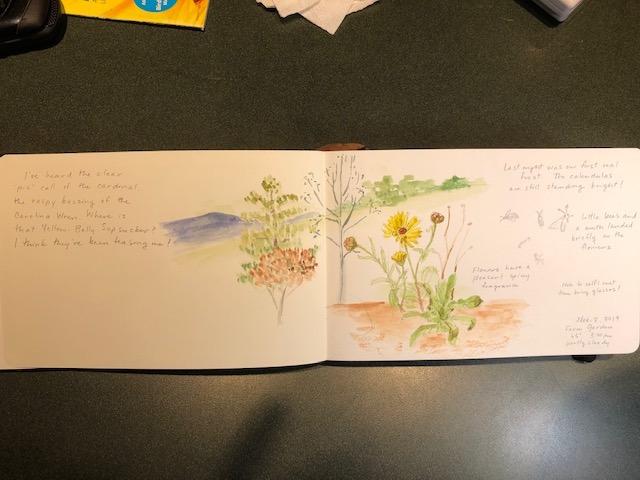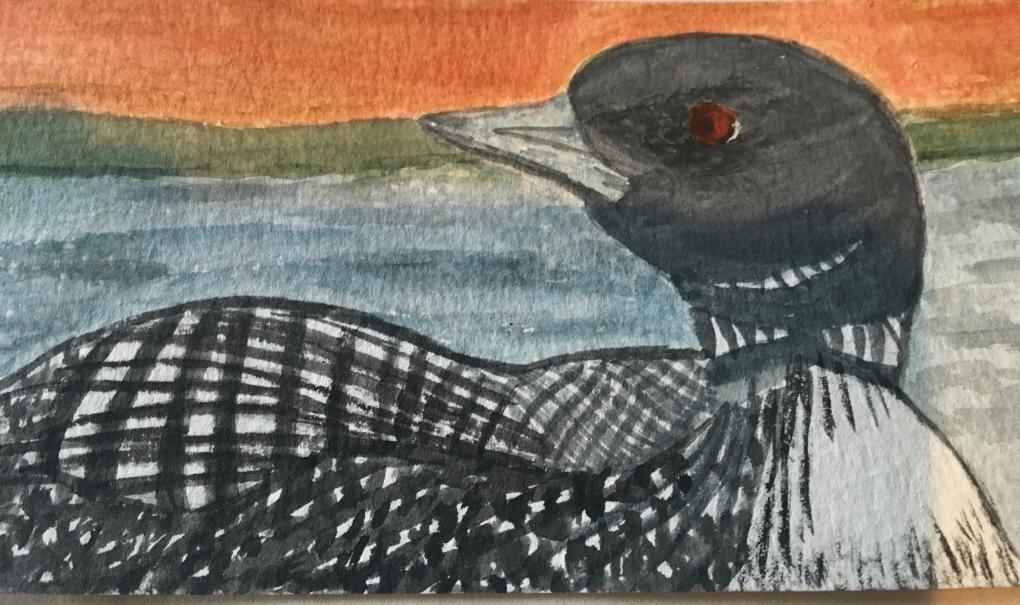The Cornell Lab Bird Academy › Discussion Groups › Nature Journaling and Field Sketching › Filling Your Sketches with Color
-
 This wasn’t from a field observation but rather from an book. Used the same general technique as in the lesson.
This wasn’t from a field observation but rather from an book. Used the same general technique as in the lesson. -
Lovely!
-
Amazing book!, i have it near and it looks super alike
-
-

-

-
I love the way you have captured the delicate features of this hummingbird's face and beak. Fascinating!
-
-
organizing my supplies is not so hard for me, I just keep it all in my backpack and try to bring a few sheets of paper towels with me. As far as recording my observations I definitelybneed to integrate that more as I have been focusing in improving my drawings and practicing painting.

-
I just got back from vacation at a VRBO in the woods that had a nice variety of birds come to the deck to feed. I was there every morning when they came for breakfast taking photos with my phone, which weren't very good but good enough to get the postures. For each type of bird I saw, I sketched from my photos and then found a nice, clear image on line to paint from. I love sketching but watercolor makes me tense. I hope to overcome that with more practice...I have a lot more birds left to sketch and paint!

-
Really nice Maggie!
-
-
Did these two pages for this lesson. The squirrel is from a photo near Yellowstone last summer. I started with a quick sketch, then went back in for the details, then got the watercolors going. Fun to mix the colors to match the photo. Really helpful to use the color guide on the box since they don't always look the same dry as wet. For the outdoor portion I walked down by our nearby river with my journal and pencil and did a quick sketch of an old cottonwood along with a couple of doug firs and some shrubs and grass. As there were snow showers in the area, I took a photo and went back inside to do the watercolor. Looking forward to a nice day to take the whole production outside. It turned out to be more of a landscape than a nature study, but I did observe that the needles on firs and pines seem to be little disks or blobs of green overlaid on the branches. Still trying to get a good watercolor technique for that, along with the trees up on the ridge. For the snowy background, I like the dry on dry technique to get interspersed white patches.


-
Love the chipmunk.
-
-
1. I have difficulty organizing materials in the field. I have bags and tins for each item, but I find myself digging in those organizers for the colors or tools I need. 2. I've used the watercolor to roughly sketch in the colors I see in the field. I must draw too small or need a finer point brush for the details. I find I'm mixing color pencils into the watercolor sketches to get the details into the image. However, what I do love about watercolors is the wash for backgrounds that are out of focus. It give you the impression of the background. It's a nice effect. 3. I'm not thrilled with my results here. As I mentioned, I struggled with details.

-
 1)I do have trouble organizing my materials! At least, I have dedicated a bag for supplies so they are easy to grab. I would like to get a small board to clip everything to as a base for holding paint and my journal--artist friends have recommended that. 2)I think that one of the benefits of painting in the field is that it makes me slow down, listen, and think. For example, why are some ducks in breeding plumage now, but other duck species won't be in breeding plumage until much later?
1)I do have trouble organizing my materials! At least, I have dedicated a bag for supplies so they are easy to grab. I would like to get a small board to clip everything to as a base for holding paint and my journal--artist friends have recommended that. 2)I think that one of the benefits of painting in the field is that it makes me slow down, listen, and think. For example, why are some ducks in breeding plumage now, but other duck species won't be in breeding plumage until much later? -

-
Is your robin done with wet on wet technique? I really like how you layered the orange to show the contour on the robin.
-
-
I used a reference photo. The sky is wet on wet. Some of the fur is brushed with a drier brush. It is easier on good watercolour paper- I find the mixed media paper is thin. I used a fine marker for the black areas. It is not forgiving when you make a mistake. It was a challenge with the shades of fur so it was good practise with refining colour and tones and shades. Using the negative space and the proportion tricks was very helpful!

-
I like how you drew the detailed fur just at the edges of the body! Did you remove water from the brush to draw such detailed lines?
-
@Constance That's what I'm trying for more detail, but I wonder if a fine point brush would be better. Still not sure how the detailed pencil lines are supposed to integrate into the watercolor.
-
@Craig Yes,I am thinking of getting a finer point brush or using the Micron pen that was recommended for the course. I have tried to figure out the pencil line thing, too. I think they are just a guide for the water color, maybe? I definitely need to know more about technique.
-
-
 I've been enjoying this course and learning so much about water color(you have to let it dry, try a paler color than you think at first and just enjoy the process). I haven't been outside to try and paint a landscape but looking forward to trying that.
I've been enjoying this course and learning so much about water color(you have to let it dry, try a paler color than you think at first and just enjoy the process). I haven't been outside to try and paint a landscape but looking forward to trying that. -
 Working on adding color and using references, this one still needs more layering but getting there.
Working on adding color and using references, this one still needs more layering but getting there.
-
 First watercolor sketch in the field. I highly recommend a thermos of tea for chilly days! I wish I’d remembered to bring a paper towel or rag, but otherwise I was happy with my kit.
I enjoyed the process immensely. Working in color, I see things I wouldn’t notice if I were just drawing or writing, like how much moss was on the gnarled oak that is the focal point. And it’s fun mixing colors, though I quickly ran out of palette space. If I had it to do over again, I think I would use dry-on-dry for a lot of that tree, different layers of different colors.
I have a lot to learn before I can get sketches out of the ugly duckling stage in less than an hour, but looking at it now I realize how much the sketch brings back: not just the tree but the feeling of sitting right next to the creek in the damp air and hearing all the birds around me. This little creek is a tiny ribbon of woodland in ag fields and the birds, well, flock to it.
First watercolor sketch in the field. I highly recommend a thermos of tea for chilly days! I wish I’d remembered to bring a paper towel or rag, but otherwise I was happy with my kit.
I enjoyed the process immensely. Working in color, I see things I wouldn’t notice if I were just drawing or writing, like how much moss was on the gnarled oak that is the focal point. And it’s fun mixing colors, though I quickly ran out of palette space. If I had it to do over again, I think I would use dry-on-dry for a lot of that tree, different layers of different colors.
I have a lot to learn before I can get sketches out of the ugly duckling stage in less than an hour, but looking at it now I realize how much the sketch brings back: not just the tree but the feeling of sitting right next to the creek in the damp air and hearing all the birds around me. This little creek is a tiny ribbon of woodland in ag fields and the birds, well, flock to it. -
Did you use glazing black over blue to darken the reflection on the water? Very effective! I also need to find a way to work more quickly; I have to work faster before it starts raining! I would like to get to where I am done in less than an hour, too. I wonder if it just takes practice or if there are tips for working more quickly.
-
-
I was going to go out today and sketch but the windy 18 degree F weather sent me back inside. My paint would have frozen faster than it dried. Outdoor nature journaling is a challenge in New Hampshire this time of year.
-
 First I painted the chiminea, then I came back and added the foreground and background. I haven't had time do a landscape at my favorite spots yet. But I'm looking forward to increasing my skills. I'm having a lot of fun especially mixing the colors. I'm looking forward to adding color to my journal.
First I painted the chiminea, then I came back and added the foreground and background. I haven't had time do a landscape at my favorite spots yet. But I'm looking forward to increasing my skills. I'm having a lot of fun especially mixing the colors. I'm looking forward to adding color to my journal. -
A comparison study with color added.

-
 After having gone back to the same area many times to practice gesture drawing I decided to compose a journal page with a few of the birds and squirrels that I had watched and drew. What struck me was all of the different journal pages that I would enjoy doing just at this one location. One of the things that is always a struggle for me is depicting the horizon in a realistic manner.
After having gone back to the same area many times to practice gesture drawing I decided to compose a journal page with a few of the birds and squirrels that I had watched and drew. What struck me was all of the different journal pages that I would enjoy doing just at this one location. One of the things that is always a struggle for me is depicting the horizon in a realistic manner. -
Your sky is done so well! Is that wet on wet?
-
-
I had a fun time painting this experience at Big Sur, California. I love going by the coast, and I particularly like it when it's overcast and the water transitions into a darker color than its usual blue/green color. I'm excited to practice in different environments and experiment with all the colors in my palette.

-
I really like your coast painting!
-
-

 Two drawings from the same sit spot. I am finding these exercises are helping me loosen up and work faster, not paying so much attention to detail, but rather focusing on composition, shape, and gesture. Just getting used to juggling my materials in the field.
Two drawings from the same sit spot. I am finding these exercises are helping me loosen up and work faster, not paying so much attention to detail, but rather focusing on composition, shape, and gesture. Just getting used to juggling my materials in the field. -
 Mixing the colors was fun. I’ve been to the zoo a couple of times, doing some sketching there, and also taking pictures for later. I need more practice with negative space; yellow frog came out a bit crumpled. In a backpack I carry little bottles of water around as well as my paint set and brush and paper towel. Also a little stool. Sketching and painting from a photo is way different than real life—I was trying for a buffalo outside, but it started to snow, and my wet sketchbook would accept neither pen nor pencil.
Mixing the colors was fun. I’ve been to the zoo a couple of times, doing some sketching there, and also taking pictures for later. I need more practice with negative space; yellow frog came out a bit crumpled. In a backpack I carry little bottles of water around as well as my paint set and brush and paper towel. Also a little stool. Sketching and painting from a photo is way different than real life—I was trying for a buffalo outside, but it started to snow, and my wet sketchbook would accept neither pen nor pencil. -
 Learning to draw and using watercolors for the first time has been a fun experience. Here is my first crack at watercolor (from a postcard I received from Germany) and I'm mostly happy with it. I need to make a bigger effort to set aside time everyday to practice drawing and mixing colors!
Learning to draw and using watercolors for the first time has been a fun experience. Here is my first crack at watercolor (from a postcard I received from Germany) and I'm mostly happy with it. I need to make a bigger effort to set aside time everyday to practice drawing and mixing colors! -
This is really nice!
-
-
i maybe cheated a little, i painted this from my window, so i was able to have all my supplies out on the table. i need to come up with a way to have a clean water cup while out in the field. my paint tin is fairly small, so it's easy to carry around. i really love using color to capture shadows, more so than just with pencil.

-
Nice painting. Maybe because I live in the Bronx.
-
-
Over all I'm pretty happy with this with this first try. I do think the edges of black on the wings and tail feathers could have softer edges and the body outline could be better. I see that practice is still needed!

-
I see the value of planning the page layout, yet I do enjoy just letting it happen!

-
Lovely page!
-
-
This is my first water color effort. The loon was pictured in a calendar. The class has been a joy especially in the chilly Minnesota fall. I have a lot of questions about going forward, but look forward to discovering the answers.

Read More:
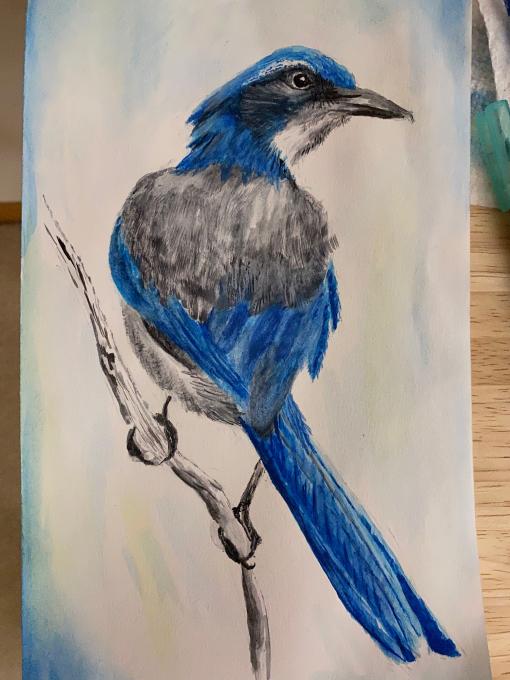 This wasn’t from a field observation but rather from an book. Used the same general technique as in the lesson.
This wasn’t from a field observation but rather from an book. Used the same general technique as in the lesson. 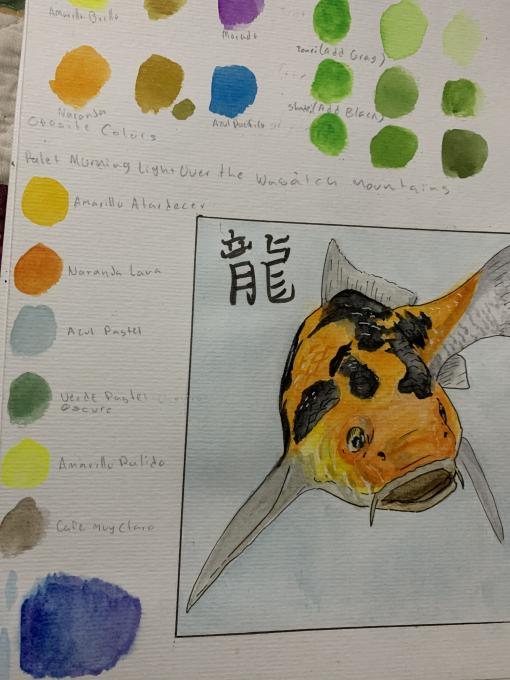

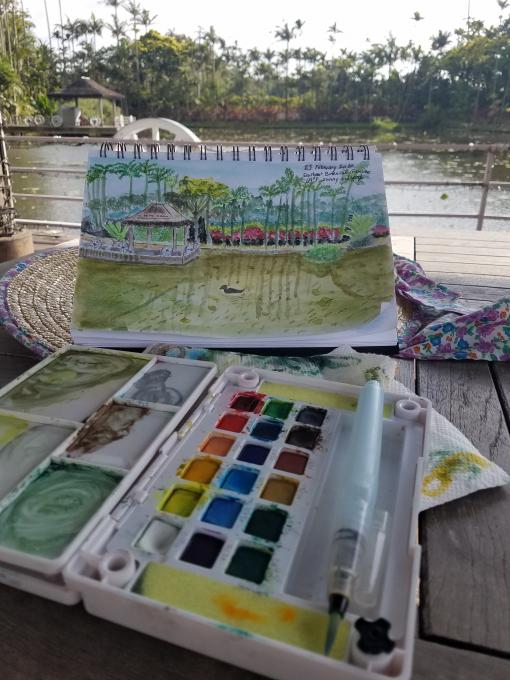
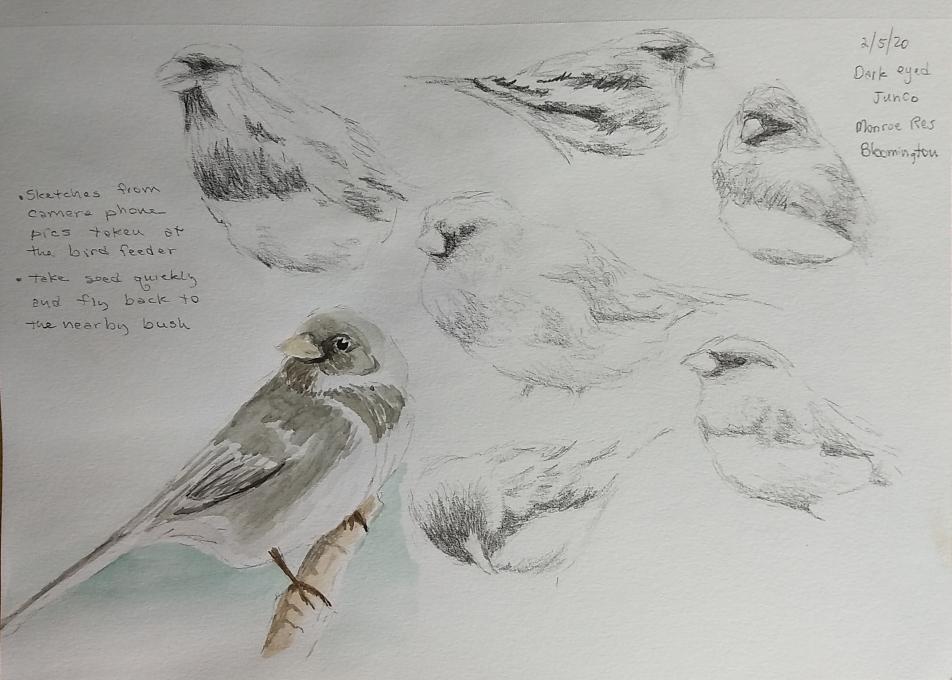

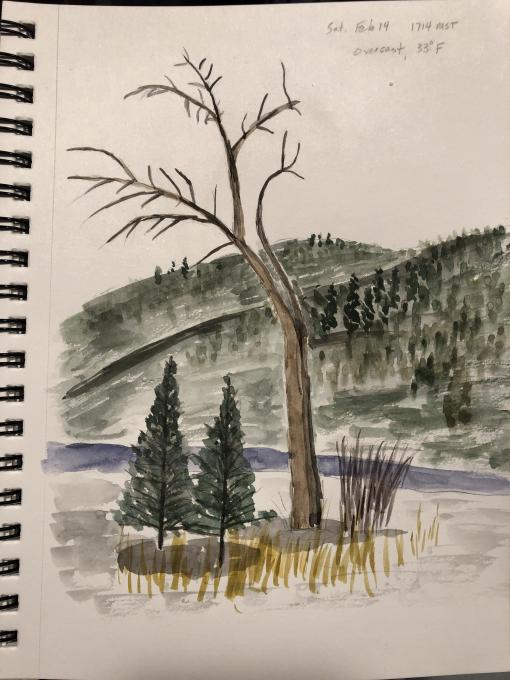
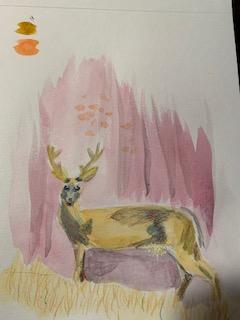
 1)I do have trouble organizing my materials! At least, I have dedicated a bag for supplies so they are easy to grab. I would like to get a small board to clip everything to as a base for holding paint and my journal--artist friends have recommended that. 2)I think that one of the benefits of painting in the field is that it makes me slow down, listen, and think. For example, why are some ducks in breeding plumage now, but other duck species won't be in breeding plumage until much later?
1)I do have trouble organizing my materials! At least, I have dedicated a bag for supplies so they are easy to grab. I would like to get a small board to clip everything to as a base for holding paint and my journal--artist friends have recommended that. 2)I think that one of the benefits of painting in the field is that it makes me slow down, listen, and think. For example, why are some ducks in breeding plumage now, but other duck species won't be in breeding plumage until much later? 
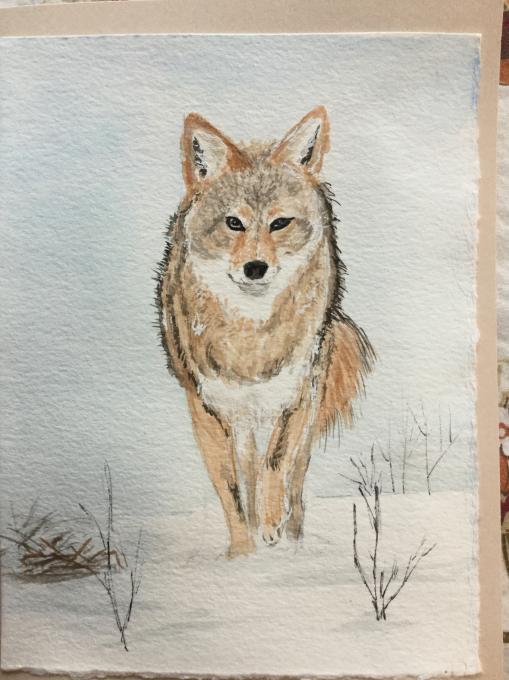
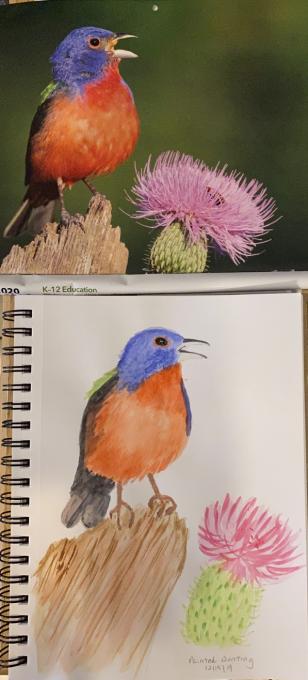 I've been enjoying this course and learning so much about water color(you have to let it dry, try a paler color than you think at first and just enjoy the process). I haven't been outside to try and paint a landscape but looking forward to trying that.
I've been enjoying this course and learning so much about water color(you have to let it dry, try a paler color than you think at first and just enjoy the process). I haven't been outside to try and paint a landscape but looking forward to trying that.  Working on adding color and using references, this one still needs more layering but getting there.
Working on adding color and using references, this one still needs more layering but getting there.
 First watercolor sketch in the field. I highly recommend a thermos of tea for chilly days! I wish I’d remembered to bring a paper towel or rag, but otherwise I was happy with my kit.
I enjoyed the process immensely. Working in color, I see things I wouldn’t notice if I were just drawing or writing, like how much moss was on the gnarled oak that is the focal point. And it’s fun mixing colors, though I quickly ran out of palette space. If I had it to do over again, I think I would use dry-on-dry for a lot of that tree, different layers of different colors.
I have a lot to learn before I can get sketches out of the ugly duckling stage in less than an hour, but looking at it now I realize how much the sketch brings back: not just the tree but the feeling of sitting right next to the creek in the damp air and hearing all the birds around me. This little creek is a tiny ribbon of woodland in ag fields and the birds, well, flock to it.
First watercolor sketch in the field. I highly recommend a thermos of tea for chilly days! I wish I’d remembered to bring a paper towel or rag, but otherwise I was happy with my kit.
I enjoyed the process immensely. Working in color, I see things I wouldn’t notice if I were just drawing or writing, like how much moss was on the gnarled oak that is the focal point. And it’s fun mixing colors, though I quickly ran out of palette space. If I had it to do over again, I think I would use dry-on-dry for a lot of that tree, different layers of different colors.
I have a lot to learn before I can get sketches out of the ugly duckling stage in less than an hour, but looking at it now I realize how much the sketch brings back: not just the tree but the feeling of sitting right next to the creek in the damp air and hearing all the birds around me. This little creek is a tiny ribbon of woodland in ag fields and the birds, well, flock to it. 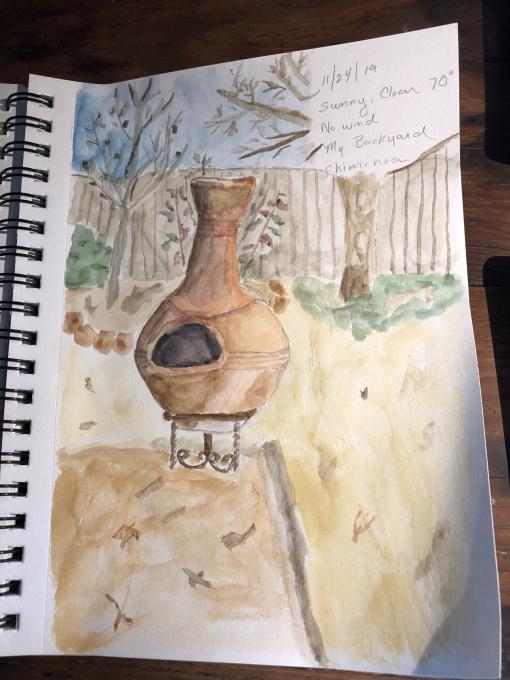 First I painted the chiminea, then I came back and added the foreground and background. I haven't had time do a landscape at my favorite spots yet. But I'm looking forward to increasing my skills. I'm having a lot of fun especially mixing the colors. I'm looking forward to adding color to my journal.
First I painted the chiminea, then I came back and added the foreground and background. I haven't had time do a landscape at my favorite spots yet. But I'm looking forward to increasing my skills. I'm having a lot of fun especially mixing the colors. I'm looking forward to adding color to my journal. 
 After having gone back to the same area many times to practice gesture drawing I decided to compose a journal page with a few of the birds and squirrels that I had watched and drew. What struck me was all of the different journal pages that I would enjoy doing just at this one location. One of the things that is always a struggle for me is depicting the horizon in a realistic manner.
After having gone back to the same area many times to practice gesture drawing I decided to compose a journal page with a few of the birds and squirrels that I had watched and drew. What struck me was all of the different journal pages that I would enjoy doing just at this one location. One of the things that is always a struggle for me is depicting the horizon in a realistic manner. 
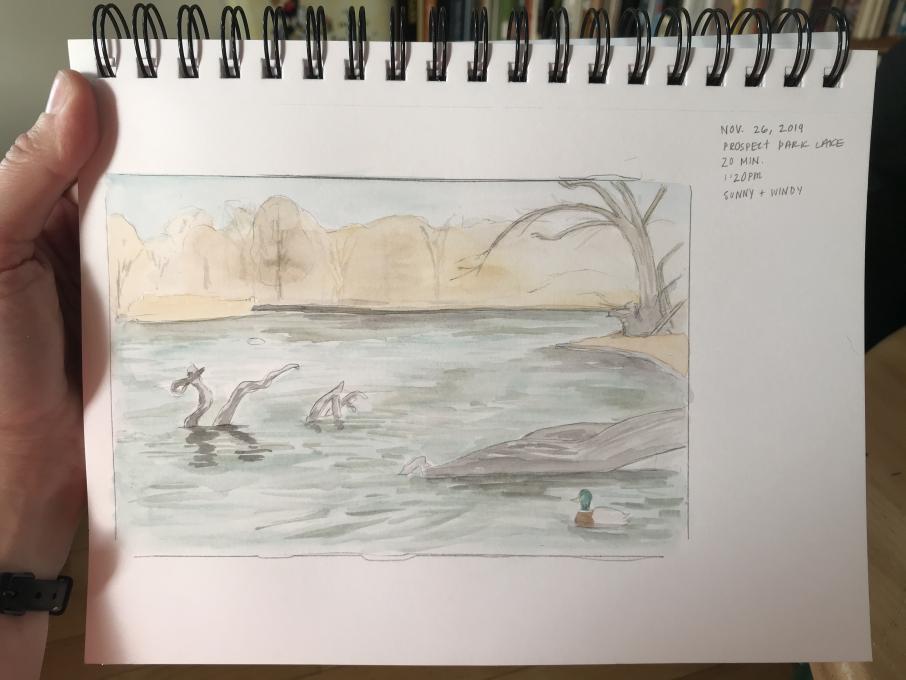
 Two drawings from the same sit spot. I am finding these exercises are helping me loosen up and work faster, not paying so much attention to detail, but rather focusing on composition, shape, and gesture. Just getting used to juggling my materials in the field.
Two drawings from the same sit spot. I am finding these exercises are helping me loosen up and work faster, not paying so much attention to detail, but rather focusing on composition, shape, and gesture. Just getting used to juggling my materials in the field. 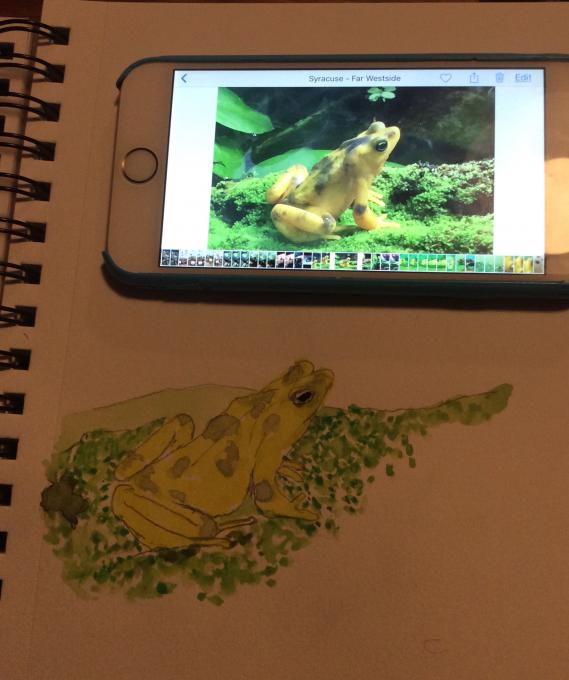 Mixing the colors was fun. I’ve been to the zoo a couple of times, doing some sketching there, and also taking pictures for later. I need more practice with negative space; yellow frog came out a bit crumpled. In a backpack I carry little bottles of water around as well as my paint set and brush and paper towel. Also a little stool. Sketching and painting from a photo is way different than real life—I was trying for a buffalo outside, but it started to snow, and my wet sketchbook would accept neither pen nor pencil.
Mixing the colors was fun. I’ve been to the zoo a couple of times, doing some sketching there, and also taking pictures for later. I need more practice with negative space; yellow frog came out a bit crumpled. In a backpack I carry little bottles of water around as well as my paint set and brush and paper towel. Also a little stool. Sketching and painting from a photo is way different than real life—I was trying for a buffalo outside, but it started to snow, and my wet sketchbook would accept neither pen nor pencil. 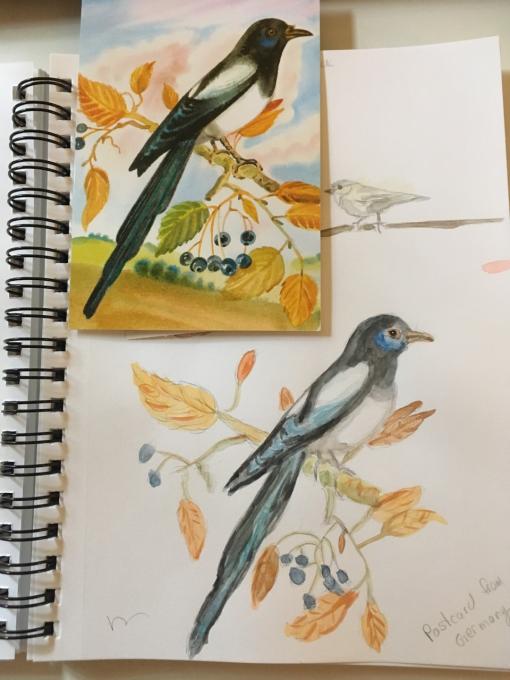 Learning to draw and using watercolors for the first time has been a fun experience. Here is my first crack at watercolor (from a postcard I received from Germany) and I'm mostly happy with it. I need to make a bigger effort to set aside time everyday to practice drawing and mixing colors!
Learning to draw and using watercolors for the first time has been a fun experience. Here is my first crack at watercolor (from a postcard I received from Germany) and I'm mostly happy with it. I need to make a bigger effort to set aside time everyday to practice drawing and mixing colors! 

